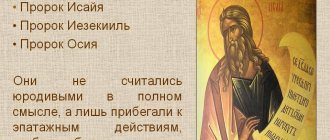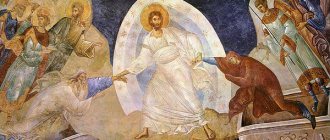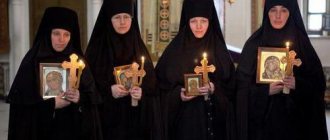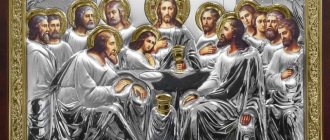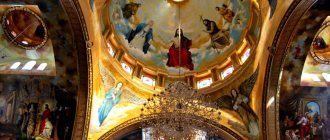Any religion needs a scripture that would concisely set out the basic principles of religion. In Christianity, such a book is called the Catechism.
In our time, books of this kind have become reference books on the basics of religion. They contain unambiguously interpreted dogmas of the faith, setting out in a form accessible to all believers what the church considers necessary to know for any Christian, as well as for a person just embarking on the path to Christ.
What is a catechism
Initially, in Christianity, in accordance with the New Testament, this was the instruction given to those preparing to receive Baptism. It was given to neophytes orally by both priests and laymen who had long ago accepted Christ.
Origin of the word
The word comes from the Latin catechēsis, which in turn came to Latin from the ancient Greek κατήχηση, which means “teaching, instruction.”
Meaning of the term
Catechism is the name of a text published with the blessing of the highest hierarchs of the Church, containing the basics of religious doctrine and intended for the instruction of believers. In some cases it takes the form of questions and answers.
History of appearance
Instructive texts arose from the conversations of the first Christians, including the Apostle Paul, with neophytes who wanted to convert to the faith of Christ. These conversations concerned not only the great mystery of Salvation, but also the path that should lead to it for everyone who has chosen the Son of Man as their guide.
The first doctrinal book
For the first time, the canons of Christianity for neophytes were systematized at the turn of the first and second centuries.
The text entitled “The Teaching of the Twelve Apostles,” or “Didache,” which was referred to by many ancient Christian authors as the work of the apostles, was considered lost, but in the 80s of the 19th century it was found by Metropolitan Philotheus Bryennios.
A Greek manuscript from 1056, kept in Constantinople, contained the only complete version of the Didache known to date.
The creators of the “Teaching” quoted sayings on the topics of faith and morality that have not reached us in other sources. The first catechetical manuscript opens with an exposition of the doctrine of the “two paths”: life and death; This is followed by chapters devoted to issues of church life, including the Sacraments, the third part reveals the deep meaning of the sermon, and the last, 16th chapter is a brief summary of the Apocalypse.
Doctrine books in the Middle Ages
At a time when Christianity from being persecuted becomes the dominant religion, attempts begin to unify the catechetical experience accumulated by the Church over half a millennium.
Cyril of Jerusalem, Blessed Augustine and John Chrysostom in the 5th-6th centuries, and two centuries later - John of Damascus create examples of Christian teachings, which later became the foundation for such texts.
From these teachings, neophytes could learn about:
- Sacraments;
- commandments and sins;
- the meaning of the Holy Gifts;
- Creed;
- the meaning of the prayer of Christ.
In the 11th century, Bruno of Würzburg compiled a book that became the first textbook for clergy, and in the 13th century, Thomas Aquinas explained the basic concepts of religion in simple language. It is worth noting that until this time, priests were not required to in any way explain to parishioners the meaning of the Creed during services, and only in 1254 did the Council of Albia oblige them to educate the believers.
Despite the thousand-year tradition of Christian instruction, the first catechetical book in the understanding that is given to it today appeared only in the era of the Reformation. It was the work of Luther's follower Andreas Althamer, containing a dogmatically verified statement of the principles of religion.
The desire of Lutherans to simplify the understanding of religious rites by believers was expressed in the doctrinal works compiled by Martin Luther himself, as well as in the books of his students - Calvin, Melangton, and adherents of Zwingli. At the same time, in contrast to the Protestant ones, Catholic religious books, written mainly by Jesuits, were published en masse.
For example, in 1554, the Jesuit Peter Canisius compiled a Catholic manual, which was published more than four hundred times over the next two hundred years.
In Muscovite Rus', which replaced the Kyiv Russia that perished under the onslaught of the Tatars, there were no short written instructions for teaching believers. Before receiving Baptism, adults were not particularly prepared, and until the 17th century, the main dogmas of Christianity were not collected together, but were published in primers and various educational codes.
The oldest catechetical text that has come down to us can be called the “Instruction to the Brethren” of the 11th century by Bishop of Novgorod Luke Zhidyata, in which the author exhorts neophytes who have not yet freed themselves from the influence of paganism.
In the tradition of the Eastern Slavs, the first book of catechetical direction was created in the middle of the 16th century by Simon Budny, a Lutheran from Belarus. He presented his book as “Ancient Christian Science, from Holy Scripture, for ordinary people of the Russian language.”
The first Orthodox doctrinal book was written by Lavrentiy Zizaniy. Canonical inaccuracies forced it to be banned, but the Kiev Metropolitan Peter Mohyla managed in 1640 to compile the “Orthodox Confession of the Catholic and Apostolic Church of the East” in such a way that it has become to this day a classic example of the presentation of Orthodox doctrine. True, when giving arguments against Protestantism, Metropolitan Peter relied on Catholic principles, which, however, did not prevent his book from taking pride of place on the shelves of Orthodox libraries.
The main Orthodox book on teaching the faith is considered to be the work of Moscow Metropolitan Philaret (Drozdov), which will be discussed in more detail below.
Current situation
As for the doctrinal book of the Catholic Church, its modern version was created by the corresponding Synodal Commission, and approved in 1992 by Pope John Paul II with the bull “Laetamur magnopere”. Translated into many languages, the work contains 2865 articles.
In 2008, the Council of Bishops of the Russian Orthodox Church instructed the Synodal Biblical and Theological Commission, headed by Metropolitan Hilarion (Alfeev), to create an Orthodox catechetical book in tune with the times.
The work, in which the best theologians of the Orthodox Church took part, was completed at the beginning of 2016 and handed over to the hierarchs of the Russian Orthodox Church for discussion and review.
In the modern history of Russian Orthodoxy, catechetical texts have been published more than once. Attempts to get away from scholasticism, the search for new forms and methods of addressing particular addressees, gave rise to a whole series of texts aimed at presenting the canons of Orthodoxy in the most accessible form.
There are also publications designed to help a newly converted Christian, who does not fully understand the doctrine, comprehend the nuances of church life. Among them are the teachings of Bishop Alexander (Semyonov-Tyan-Shansky), as well as the family book “God Lives.”
Those who are looking for their own path in the Church should read “Conversations on Faith and the Church” by Metropolitan Anthony and “I Believe: Conversations on the Creed” by Archpriest Alexander Men.
The tradition of the first Christians distinguished between those who come to Christ and those who are chosen to serve Him. For such people, even during the times of persecution of the church by the Soviet government, “Catechetical Conversations with Those Being Baptized” were created by Archimandrite Boris (Kholchev) and a manual to help the catechumens, that is, those preparing to accept Baptism, by priest Georgy Kochetkov.
Manuals for catechists include, for example, “The Beginning of a Christian’s Path” by Archpriest Alexander Borisov.
CATECHISM
K. in Greek Orthodoxy. traditions until the 17th century. there was no such thing as an independent type of theological literature. The appearance of the one who had the app. the origin of the K genre was caused by purely external circumstances.
After the fall of Byzantium, the Eastern Church was involved in the disputes between Catholics and Protestants that resulted from the Reformation. The canonical territories of the Eastern Church were subordinated to the Turks and Catholic powers (Venetian and Genoese republics). The position of the Orthodox in those territories of the East was not easy either. Europe, where the Orthodox were forced to resist the proselytizing policies of Protestants and Latins. The controversy with the latter dates back to the beginning. II millennium and had a long history after the Great Schism of 1054, accompanied by periodic attempts to conclude a union.
In this situation, from the Orthodox Church. The Church needed to formulate its position on plurality. questions of doctrine, in particular, on those on which no conciliar dogmatic decisions were made in the era after the Ecumenical Councils, which was a consequence of both the specifics of the development of Orthodoxy. theology, and the absence in the East of a number of heresies, including the Eucharistic, which gave rise to the Reformation movement. Thus, the controversy was conducted both against the Latins and against the Protestants (Lutherans and Calvinists). In addition to this, the decline of education among the Greeks in the post-Byzantine period. time and the development of printing in Europe put the Greek Church in a difficult position. Most Greek and Russian theologians of the 16th-17th centuries. received education in the West. un-tah and fell under the Catholic. or Protestant. influence. Many went from pro-Catholic. positions towards Protestant ones (as, for example, in the case of Patriarch Cyril I Lucaris). The reason for this was, among other things, the lack of Catholicism among Orthodox Christians. previous polemics with Protestantism, which arose in the 16th century, in contrast to the Greco-lats, which had a long history. controversy, as well as anti-Catholic. the direction of the Reformation, which denounced many. superstitions that also existed among the Orthodox. Therefore, the penetration of Protestants posed a particular danger to the Orthodox. ideas in Greek theology.
The first example of official. Theological discussion between Orthodox and Protestants is the correspondence of the Polish Patriarch Jeremiah II Thranos († 1595) with Lutherans. theologians. In 1573 German. imp. Maximilian II sent his ambassador David Ungnad von Sonneck to K-pol, who was accompanied by a Lutheran. Pastor Stefan Gerlach. The latter brought with him letters from the famous Tübingen theologian Jacob Andreae and one of his colleagues, Prof. Ancient Greek language of Martin Crusius, written with the aim of starting a discussion with the Orthodox. On May 24, 1575, Gerlach appeared at the Patriarchate and personally presented the Greek to the Patriarch. version of the Augsburg Confession and letters from Andreas and Crusius. In 1576, Patriarch Jeremiah responded to the Tübingen people with a detailed message (the 1st - later correspondence continued), in which he outlined the foundations of Orthodoxy. creeds (see: Καρμίρης. 1960. Τ. 1. Σ. 437-503).
“Orthodox teaching” (᾿Ορθόδοξος διδασκαλία) of the Patriarch of Alexandria Meletius I Pigasus (1549 - September 13, 1601) marks the beginning of theological literature in folk Greek. language. The work belongs to the genre K. Patriarch Meletius examines the concept and essence of Christianity, considers, without entering into polemics, controversial points in relations with the Latins (Filioque, purgatory, primacy of the Bishop of Rome, etc.) in accordance with the teachings of the blessed. Augustine, bishop Hippo (“On the Trinity”). The writings of Boethius, Thomas Aquinas and Gennadius II Scholarius are also quoted in a positive manner. A long passage in the dialogue between teacher and student focuses on justification, faith and works, providence and predestination; blzh. Augustine plays the role of the main source (Podskalsky. Griechische Theologie. S. 132).
Question-answering K. with a clear organization of internal material and division into traditions. parts - the decalogue, the Creed, the “Our Father” and the sacraments - were created precisely by “Protestant” theologians in Greek. Churches in the beginning XVII century The first author to become a Protestant guide. views in Greek printed books, there was Zechariah Gergan (2nd half of the 16th century - after 1626). A native of Arta, Gergan first wanted to study in Rome (1616), but then, thanks to a scholarship from the Elector of Saxony, Johann Georg I, he began studying languages and theology in Wittenberg (c. 1619-1621). In 1622, his book was published there, to which Hertz was dedicated. Johann Georg and had the title “Christian Catechism for the glory of the Humane God the Father, Jesus Christ and the Holy Spirit for the honor and help of the God-loving Greeks” (Legrand. Bibl. hell. XVIIe. T. 1. P. 159-170, N 119). The Christian Catechism was written in Modern Greek. language and was clearly anti-Catholic. character, as the author reports in the preface.
Gergan was worried about the Greeks who had fallen under Rome. influence. It is possible that this work was directed directly against the publication in 1616 in Rome (Paris, 16332; Rome, 16373; see: Legrand. Bibl. hell. XVIIe. T. 1. P. 104-108, N 37; Ibid . P. 309-315, N 223; P. 347-348, N 256) modern Greek. translation of the "Large Catechism" card. Robert Bellarmine (Doctrina christiana; Διδασκαλία χριστιανική), executed by the Athenian scientist and diplomat Leonard Philara (1595-1673) (Podskalsky. Griechische Theologie. S. 160-161). This translation had a noticeable influence in Greek. Churches. Thus, Kirill Lukaris immediately supplied the 1st ed. translation of the “Large Catechism” with critical notes (Rozemond. 1963), and Met. Peter (Mogila) quoted him approvingly in his Orthodox Confession. The Large Catechism has been translated into 60 languages, including Arabic, Slavic, and Romanian. Earlier, in 1602, John Matthew Caryophyllus translated the “Small Catechism” (Διδασκαλία χριστιανικὴ σύντομος) card. R. Bellarmine, works of less significant theological significance (the translation went through several editions: Legrand. Bibl. hell. XVIIe. T. 3. P. 40-42, N 666).
Anticipating attacks, Gergan apologized for the “barbaric” style, which he chose due to his lack of education in Greek. people. At the end of the preface there is the following note: “We read this theological treatise, written by Zechariah Gergan, an Ithacan Greek, a graduate of our academy, in a mixed barbarian language for the benefit of our fellow citizens, modern Greeks, and approved it in content and allowed it to be published. Dean, lord and other doctors and professors of the theological college at the Ducal University of Wittenberg" (Legrand. Bibl. hell. XVIIe. T. 1. P. 166). This is followed by dedications from Europeans. professors and teachers.
K. is structured as a dialogue between father and son and consists of 10 books. Its content is a peculiar mixture of Orthodoxy. (mostly in relation to the sacraments) and Lutherans. dogmas. As for the influence of Lutheranism on Gergan, first of all, attention is drawn to the principle of self-sufficiency of the Holy Spirit, discussed at the very beginning of K. Scripture (without the “apocryphal” books of the Maccabees) as a basis for faith. The Church Fathers are approved, but their special significance is not recognized. Christ is the Redeemer and Head of the Church; It is based on Him alone, and not on St. Peter or the Pope; the latter is reproached not only for his wealth and politics in the East. Europe, but also heresies (unleavened bread, purgatory). K. soon spread among the Greeks and penetrated into the West. Rus.
Rome immediately responded to the appearance of K. Gergan. On the instructions of the Congregation for the Propagation of the Faith, the Uniate John Matthew Caryophyllus, in his “Refutation of the pseudo-Christian catechism published by Gergan of Arta,” discovered 70 “blasphemies” in it (Rome, 1631; Legrand. Bibl. hell. XVIIe. T. 1. P. 285-288 , N 208). Along with papal primacy and purgatory, Caryophyllus focused special attention on the issue of the self-sufficiency of the Holy. Scripture as the only source of revelation. Later, Neophytos Rodinos, Lev Allatsius and Nikolai Komnin Papadopoulos also spoke negatively about K. Gergana.
“Dogmatics” (full title: “Synopsis of the divine and sacred dogmas of the Church for the benefit of Christians”, ν εἰς ὠφέλειαν τῶν χριστιανῶν) protosyncella of George (in the monasticism of Gregory) Myrmegusiana was written in the vernacular language and became quite widespread and went through 4 editions (Venice, 1635, 16652, 17783, 17814; see: Legrand. Bibl. hell. XVIIe. T. 1. P. 327-328, N 238; T. 2. P. 252-253, N 487; Idem. Bibl. hell. XVIIIe. T. 2. P. 290, N 936; P. 368, N 1056).
In the preface, the author thanks his teacher George Koressios (Koressios) (1570-1659/60), and the latter certifies the Orthodoxy of the student’s work. “Dogmatics” has the form of a K. and contains a chapter with an explanation of the “Our Father”, the Ten Commandments, the 7 Sacraments, as well as various question answers, which thematically partly coincide with the paragraphs of the “Confession” of Cyril Lucaris, but differ from them in content. Dogmatics is pro-Catholic. character. K.-l. criticism of the Roman Church is practically absent, while the followers of Luther and Calvin are called heretics. On the issue of re-baptism, a distinction is made between heresy and schism in order to conclude that the sacrament must be repeated only for non-Orthodox people. In relation to the Eucharist, the term “transubstantiation” (μετουσίωσις) is repeatedly emphasized (Podskalsky. Griechische Theologie. S. 190-191).
Patriarch of Constantinople Kirill Loukaris. Engraving. XVII century Patriarch of Constantinople Kirill Loukaris. Engraving. XVII century
The central figure in the relations between the Orthodox and Protestants in the 17th century. became Kirill Lukaris. From the beginning XVII century he was in constant communication and correspondence with Protestants. theologians and over time completely switched to Calvinism. positions, although in his early sermons con. XVI - beginning XVII century there is a closeness to the Catholic. doctrine (for example, Cyril Lucaris approves of the psychological doctrine of the Holy Trinity of St. Augustine and the term “transubstantiation”). Taking a strong anti-Catholic stance. position both theologically and politically, Cyril Loukaris wanted Greek reform. Churches, why with the support of the English. and gol. diplomats made a lot of efforts: he transformed the Patriarchal Academy and sent students to receive education as Protestants. countries: England, Holland and Germany. He was guided by the goal of countering the pressure of Rome against the backdrop of the Union of Brest in 1596, the Catholic mission in the East and the dispute over the possession of St. places in Palestine.
Cyril Lucaris also sought to contrast something equivalent to the religions published in Rome and distributed freely. literature (in particular, catechisms) in modern Greek. language, which was spread among the Greeks by Catholics. creed. This is how the plan arose to create its own printing house in K-field, which was implemented in 1627 with the help of the English. Ambassador Thomas Rowe and Nicodemus Metaxas, who had been educated in England since 1623, brought from there a complete set of equipment for the printing house. However, already the first prepared collections of works of a polemical nature (for example, about the claims of the Pope to primacy) caused the French. Ambassador Philippe de Harlay, c. de Sesi, and the Jesuits were very irritated, since this could lead to the fact that the achievement of mutual understanding between the K-field and Rome would be completely hindered by the Calvinists. the sympathies of Patriarch Kirill Lukaris will become obvious to everyone. Thus, a response plan emerged with the goal of stopping the printing house. Since Nicodemus Metaxas could not be attracted to the union, the Jesuits declared the treatise of Cyril Lucaris, “Against the Jews,” published in 1627, dangerous for the peace of the state and reported the accusations to the Turkish authorities (along with the accusations against Nicodemus Metaxas). In Jan. 1628 The Janissaries confiscated the printing equipment and took it away. Although the accusations against Cyril Lukaris, after careful study, turned out to be groundless, and the Jesuits, with the exception of 2 embassy confessors, were expelled from the capital, the returned printing house never started working due to the intervention of Venice, which was afraid of the spread of anti-Catholicism. literature in their possessions (Ibid. S. 63-64).
As evidence of the personal beliefs of Kirill Lukaris, his remarks in the margins of the Greek are of interest. translation of K. card. R. Bellarmine (Rozemond. 1963), which were made in 1618-1619. and were not intended for publication. Their analysis shows Kirill Lukaris as a theologian already close to Calvinism, but not fully formed and full of contradictions (Podskalsky. Griechische Theologie. S. 173-175). His comments can be divided into 3 groups: along with approving and clarifying remarks, there are clearly expressed personal or, most often, confessional remarks, which are either Orthodox or Calvinist. character. In addition, a number of extensive passages on the cards. R. Bellarmine left without comment. To criticism from the Orthodox Church. positions include the denial by Cyril Lukaris of the symbolism of the sign of the cross as a confession of the Most Holy. Trinity, denial of contradictory Holy Scriptures. The writing of ideas about the division of hell, about individual judgment after death and about purgatory, the rejection of the imaginary agreement between Lat. and Greek teaching about the Holy One Trinity, refusal to recognize the title of “holy father” (primacy) for the pope, except in the sense of a moral impulse, challenging transubstantiation when pronouncing the words of establishment, and not during the epiclesis, doubt regarding the view of the anointing of the sick as the “last anointing” (extrema unctio ). Links by Kirill Lukaris to the Orthodox Church. tradition as opposed to the Catholic one are not always clear, and it is not entirely clear how familiar he himself is with the historically not always uniform Orthodox Church. tradition.
Marginalia Protestant. character are of particular interest, since on their basis it is possible to more easily trace the theological development of Cyril Lucaris from the time of the first sermons, written 20 years before the compilation of the marginalia to K. card. R. Bellarmine. In this regard, it is first of all important that Cyril Lucaris emphasizes the exclusive role of Christ as the Mediator, who does not need the subordinate mediation of the Mother of God and the saints. Also in the context of Mariology, the importance of righteous deeds for salvation is rejected. Kirill Lukaris denies secret confession and the sacrificial nature of the Eucharist. Regarding his opinion on the reserve preconsecrated Gifts, it is not entirely clear whether he rejects their use in general or specifically for worship in processions. The latter is logically a consequence of the negation of the term “transubstantiation”, which in the marginalia is presented rather as an allusion.
Cyril Lucaris hoped to compose and publish his own K. in the common language for teaching the uneducated (see his letter to David de Wilhem 1618/9: Legrand. Bibl. hell. XVIIe. T. 4. P. 314, N 98). But he only managed to compose a confession of faith, which, however, played a big role in the emergence of the genre of K. in Orthodoxy. Churches. In the spring of 1629, in Geneva, under his name, the “Confession of Faith (Confessio fidei) of the Most Honorable Mr. Cyril, Patriarch of Constantinople” was published in Latin. In the same year it was translated into European languages. The main sources for him were the Reformed confessions of faith: the Belgic Confession (Confessio belgica, 1561) and the Doctrine or Establishment of the Christian Faith (Institutio christianae religionis, 1536) by Calvin. The Greek text of the “Confession” with additions was printed in parallel with the Latin in Geneva in 1633. However, the title of the Greek edition differed from the Latin and claimed to present the faith of the entire Eastern Church, and not just the theological ideas of a particular author, i.e. it presented Calvinism as a faith Greek Churches.
The appearance of the Confession led to unrest among the Orthodox, as it was used by both Protestants and Catholics in Moldo-Wallachia and Ukraine for proselytizing purposes. The activities of Cyril Lukaris and his “Confession”, due to the sharp response of Catholics and Orthodox Christians, on the one hand, ushered in an era of increased penetration of armor. scholasticism into the theology and school tradition of the Eastern Church, and on the other hand, caused the largest debate between Catholics and the French. Protestants about the scope and value of the patristic tradition. The publication of the “Confession” also caused great confusion in the southern Russian metropolitanate, which at that time was part of the K-Polish Patriarchate. Numerous Protestants immediately began to use the “Confession”. and Catholic. missionaries: the first - referring in their sermon to the authority of the Polish Patriarch, the second - accusing the Greeks of deviating from church tradition. The Jesuits, for example, when converting the Little Russians to Catholicism, citing the “Confession,” argued that the Greek. The churches, together with their patriarchs, fell into Calvinism. Although Theophan III, Patriarch of Jerusalem, in 1630, after a corresponding request, vouched for the orthodoxy of Cyril Lukaris, however, neither this statement nor the subsequent condemnation at the Polish Council in 1638 played virtually any role in eliminating the concern.
After the posthumous condemnation of Cyril Lukaris at the Polish Council of 1642, a small group of Greeks. theologians continued to collaborate with Protestants. by the West to make Protestant catechetical literature available to the Greeks. The most important fruit of this activity was the modern Greek. translation of the Calvinist “Belgic Confession”, “Heidelberg Catechism” and “Dordrecht Church Rule” (previously, in 1623, these works were published in Leiden translated into classical Greek).
Orthodox doctrinal book of Filaret (Drozdov)
Created in the 20s of the 19th century, the work of Metropolitan Philaret served as the official Orthodox catechism in Russia for many years.
about the author
Vasily Drozdov, who took monastic vows and took the name Filaret, was born in Kolomna in the winter of 1783 into the family of a priest. After graduating from theological seminary, he became a teacher, and after becoming a monk, he received the post of rector of the Theological Academy in the then capital of the Russian Empire and at the same time became the guardian of the Novgorod Yurievsky Monastery.
Bishop Filaret was elevated to the rank of archbishop in 1821, and five years later, during a difficult time for Russia after the Decembrist uprising, he became Metropolitan of Moscow and Kolomna.
Emperor Nicholas I treated the saint with suspicion, considering him too committed to “free” views, almost an oppositionist. But Alexander II, whom Vladyka Philaret anointed as king, trusted him completely and entrusted him with the most important task - drawing up a manifesto on the emancipation of the peasants.
A highly educated specialist in theology, Metropolitan Philaret translated texts of Scripture and compiled a confessional book, which for many years served as a model for such instructions.
The bishop, who died in the fall of 1867, rested in the Trinity-Sergius Lavra, and in 1994 he was canonized.
The essence and content of the book
The essence of the work, written in the classic form of questions and answers, according to its creator, is instruction in the Orthodox Christian faith. In order for soul-saving reading to have an effect, it is necessary not only to know the True God and believe in Him, but also to live by faith and do good deeds.
In 1823, the first edition of the book was published. The book caused heated debate, because it was presented in “simple” language, and this could not please Orthodox conservatives. first of all, to the Minister of Public Education, Admiral A. S. Shishkov, Archimandrite Photius (Spassky) and the influential member of the State Council at that time, A. A. Arakcheev.
Therefore, Bishop Philaret had to make edits, but the main content, including sections on Faith, Hope and Love, as well as the form of presentation of the material, remained the same.
Goal of the work
At the beginning of the 19th century, the Russian Orthodox Church used in its everyday life mainly the doctrinal works of Metropolitans Peter (Mogila) and Plato (Levshin). But the first was criticized for its Catholic bias, and the second for its Protestant bias, so the need arose to create an educational book, free from any heterodox influence.
In addition, in 1816, the translation into Russian of the New Testament and Psalter was begun and completed six years later. Consequently, quotations from the Holy Scriptures in religious books had to be brought into line with the new translation. Therefore, in 1822, the Holy Synod decided on the need to create a new catechetical book.
Document structure
Philaret Drozdov’s “Long Catechism” begins with an introduction that defines the basic terms of Orthodox doctrine and examines Divine Revelation, Sacred Tradition and the Bible from the point of view of Orthodoxy.
The main part of the book is devoted to Christian virtues - Faith, Hope and Love.
In the part “On Faith” the emphasis is placed on the Orthodox interpretation of the Nicene-Constantinopolitan Creed, excluding the Catholic filioque, i.e. the procession of the Holy Spirit from not only the Father, but also from the Son.
The chapter “On Hope” is devoted to explaining the concept of Christian Hope. Here, after a deep analysis of the meaning of prayer, the prayer of Christ “Our Father” is considered.
For teaching purposes, the prayer is divided into an invocation to the Lord (“Our Father, Who art in heaven!”), seven petitions to Him and a doxology with which the prayer ends (“For Thine is the kingdom, and the power, and the glory forever, Amen”) .
Part three - “On Love” - examines the Ten Commandments of God: the four commandments of love for God of the first table and the six commandments of love for one’s neighbor of the second table. For each of them, the chapter contains the instructions necessary for observance and describes the sins that are most often committed against one or another commandment.
The book ends with a final word on the correct and godly application of the principles of faith.
In the work of Bishop Philaret, all excerpts from Scripture are published in Church Slavonic, and the texts of the Holy Fathers are published both in Old Church Slavonic and in the contemporary Russian language of its creator. The nuances of the book include the fact that its style is deliberately given an archaic sound, noticeable even at that time. For example, the phrase “in what sense” is replaced with “in what power”: “In what power is it said that Jesus Christ was crucified for us?” This stylistic feature does not at all interfere with the perception of the text, but serves to strengthen the spiritual and historical component of this doctrinal manual.
Catechism of the Catholic Church
Catholics published their last updated doctrinal book in 1992, during the pontificate of Pope John Paul II.
The essence and content of the book
By catechesis, Catholics initially understood the practice of the Church, which they proclaimed as the Body of Christ, in teaching Christians the basics of religion, educating believing youth, as well as in introducing to the Church those who want to know the truth, but do not know which way to go.
Therefore, Catholics combine teaching the principles of religion with the education of faith in children, youth and adults on the basis of organically and systematically taught Christian doctrine, which together is designed to introduce parishioners to the fullness of Christian life.
The pastoral mission of the Catholic Church includes many doctrinal elements.
Catechesis as such is closely related to all components of the church structure and includes such steps as:
- awakening of faith, that is, the proclamation of the Gospel as Good News;
- helping neophytes in finding the meaning of faith and gaining experience of Christian life;
- comprehension of the essence and fulfillment of the sacraments;
- after this the neophyte must be introduced into the church community;
- Next comes the apostolic and missionary witness.
Thus, instruction in the faith for Catholics is not only about expanding the geographical scope of the Church and increasing the number of parishioners, but to a greater extent ensuring the internal spiritual growth of the Church, the conformity of its activities with the Plan of God.
Goal of the work
According to the annotation, the new edition of the CCC - the Catechism of the Catholic Church - aims to most organically present the Western Church's ideas about the fundamental principles of Christian doctrine. We are talking not only about the postulates of faith, but also about the categories of morality, as they are interpreted by the decisions of the Second Vatican Council and, in general, by the entire Church Tradition.
Based on the Holy Scriptures, the works of the Holy Fathers, liturgical texts and the Magisterium, the refined and processed text should serve as the basis for the creation of works on teaching the basics of religion in all Christian countries, as well as in territories where Christian missions exist.
The book was mainly created with catechists in mind - teachers of the faith, bishops and pastors. It is a tool designed to help teach the People of God, but it also serves as useful soul-saving reading for all Christian believers.
Document structure
The plan is based on traditional principles of creating Christian edifying literature.
It is based on four “pillars”:
- confession of faith received at baptism, that is, the Creed;
- Sacraments of faith;
- the principles of life in faith, that is, the Commandments;
- as well as the Prayer of Christ - “Our Father”.
The first part, dedicated to the confession of faith, sets out the meaning of Revelation intended by God for man. Through Revelation, God commits himself to humanity, and through faith, humanity responds to Him.
The commentary on the Creed sets out the essence of the gifts of the Lord brought to people, which means, among other things, faith in the One God, embodied in the Consubstantial Trinity: the Creator, His son Jesus Christ, and the Holy Spirit.
The second part of the book explains the meaning of the presence in the sacred actions of the liturgy of the Lord's salvation, carried out by Jesus Christ and the Holy Spirit, as well as the meaning of the seven Sacraments.
Speaking about life in faith, the third part of the book talks about the ultimate goal of human life, the existence of a person created in the image of God. Outlining the Christian understanding of blessedness and the paths leading to it, the book recommends living and acting directly and freely, guided by the Law and grace of God, keeping God’s Commandments.
The fourth part of the book talks about the meaning and significance of prayer in the life of Christians and comments on the seven petitions included in the Lord's Prayer.
CATICHISIS
- Church
there is a society established by God of people united by the Orthodox faith, the Law of God, the hierarchy and the Sacraments.
Believe
to the Church means to reverently honor the true Church of Christ and obey its teachings and commandments with the confidence that grace abides in it, acts savingly, teaches and governs, poured out from its One Eternal Head, the Lord Jesus Christ.
The Church, which is visible, is the subject of faith, while faith, according to the Apostle, is the conviction of the invisible
(confidence in the invisible). Firstly, although the Church is visible, the grace of God internalized by it and the people sanctified in it, which is, in fact, the object of faith in the Church, is invisible. Secondly, although the Church is visible, since it resides on earth and all Orthodox Christians living on earth belong to it, at the same time it is invisible, since it is also in Heaven and all those who have died in true faith and holiness belong to it .
The concept of the Church, which is on earth and at the same time heavenly, is established in the following words of the Apostle Paul addressed to Christians: come to
(you have approached)
Mount Zion and the city of the living God, heavenly Jerusalem, and the darkness of the Angels, the triumph and the church of the firstborn
(to the triumphant council and the Church of the firstborn),
written in Heaven, and God the Judge of all, and the righteous in spirit, and to Mediator of the New Covenant Jesus
(Heb. 12:22-24).
We are convinced of the presence of God's grace in the true Church, firstly, through the fact that its Head is the God-man Jesus Christ, filled with grace and truth
and His Body, that is, the Church, filling with grace and truth (John 1:14-17);
secondly, through the fact that Christ the Savior promised His disciples the Holy Spirit so that He would be with them forever, and that, according to this promise, the Holy Spirit provides shepherds for the Church (John 14:16). The Apostle Paul says about Jesus Christ that God the Father gave Him the Head above all the Church
(placed Him above all, the Head of the Church),
which is His body
(Eph. 1:22-23).
The same Apostle says to the shepherds of the Church: “Take heed therefore to yourselves and to all the flock, in whom the Holy Spirit hath made you bishops, to shepherd the Church of the Lord and God,
which he acquired
with his own blood”
(Acts 20:28).
The fact that the grace of God abides in the Church to this day and will abide until the end of the century is confirmed by the following sayings of the Lord Jesus Christ Himself and His Apostle: I will build My Church, and the gates of hell will not prevail against it
(Matt. 16, 18);
I am with you all the days to the end of the age, amen
(Matthew 28:20);
To him
(God the Father)
be glory in the Church in Christ Jesus throughout all generations and ages.
Amen (Eph. 3:21).
The Church is one because it is one spiritual body, has one Head - Christ, and is animated by one Spirit of God. One body, One Spirit, just as the calling was speedy in one hope
(as you were called to one hope)
of your calling: One Lord, one faith, one Baptism, one God and Father of all
(Eph. 4:4-6).
Jesus Christ is the One Head of the one Church. The Apostle Paul writes that for the Church as the building of God, no one can lay anything else than the one lying
(except for what is required),
who is Jesus Christ
(1 Cor. 3:9-11).
Therefore, for the Church as the Body of Christ there can be no other Head other than the Lord Jesus Christ. The Church, which must abid throughout all generations (until the end) of the age, requires a Head who always abides, and such is one Lord Jesus Christ. Therefore, the Apostles are called nothing more than ministers of the Church
(Col. 1:24-25).
The unity of the Church imposes on us the duty to maintain
(preserve)
the unity of the Spirit in the bond of peace
(Eph. 4:3).
The Church is one, but there are many separate and independent Churches, for example, Jerusalem, Antioch, Alexandria, Constantinople, and Russia. These are private Churches, or parts of the One Universal Church. The independence of their visible structure does not prevent them from spiritually being great members of the one body of the Universal Church, having One Head - Christ and one spirit of faith and grace. This unity is expressed apparently by the same confession of faith and communication in prayers and the Sacraments.
Without a doubt, there is also unity between the Church on earth and the Heavenly Church, both in their relation to the One Head, our Lord Jesus Christ, and according to the mutual communion between both.
The means of communication between the Church on earth and the Heavenly Church is the prayer of faith and love. Believers belonging to the Church laboring on earth, offering prayer to God, call for the same
time for the help of the saints belonging to the Heavenly Church; and the saints, being at the highest degrees of approach to God, with their intermediary prayers purify, strengthen and bring to God the prayers of believers living on earth, and, according to the will of God, graciously and beneficially act on them either by invisible force, or through their appearances, or in another way .
The rule of the Church on earth is to call upon the saints in prayer
Church of Heaven - based on the Holy Tradition, the beginnings of which are also visible in the Holy Scriptures.
For example, when the prophet David cries out in prayer: “O Lord God of Abraham, Isaac and Israel our father,”
then he remembers the saints to strengthen his prayer (1 Chron. 29:18).
In the same way, today the Orthodox Church calls upon Christ, our True God, through the prayers of His Most Pure Mother and all the saints.
Saint Cyril of Jerusalem, in his explanation of the Divine Liturgy, says: “We also remember those who have died before, firstly, the patriarchs, prophets, apostles, and martyrs, so that through their prayers and intercession God may accept our prayer” (Instruction on the Mysteries, 5, ch. 9).
Saint Basil the Great, in his Word for the Day of the Holy Forty Martyrs, says: “He who grieves runs to the forty (forty), and he who rejoices runs to the same: one may find resolution (receive liberation from) sorrows, the other may have good things preserved for him. Here a pious wife is seen for her children praying: she asks for the return of her departed husband, and asks for health for the ailing man. Let your petitions be with the martyrs.”
On the mediatorial prayer of the saints
in Heaven there is the testimony of the Holy Scriptures.
The Holy Evangelist John in revelation saw an Angel in Heaven, to whom was given much incense, that he might give it to the prayers of all the saints
(so that he, with the prayers of the saints, would place it)
on the golden altar that is before the Throne.
And incense smoke came out through the prayers of the saints from the hand of an Angel before God (Apoc. 8:3-4).
About the beneficial appearances of saints
from Heaven is the testimony of the Holy Scriptures.
The Holy Evangelist Matthew narrates that after the death of our Lord Jesus Christ on the cross, many bodies of the departed saints arose and, coming out of the tomb, after His Resurrection, entered into the holy city, and appeared to many
(Matthew 27:52-53). Since a miracle so important could not have happened without an important purpose, it should be assumed that the resurrected saints appeared in order to announce the descent of Jesus Christ into hell and His victorious Resurrection and with this preaching to facilitate the transition to the then opened New Testament Church for those who were born in Old Testament Church.
By the following evidence we are confirmed in the belief that the saints, upon their repose (that is, upon their transition: the death of a Christian is called the transition to Eternal Life), work miracles in one way or another. The fourth book of Kings testifies that by touching the bones of the prophet Elisha the dead was raised (2 Kings 13:21).
The Apostle Paul not only directly performed healings and miracles, but the leaders and Ubrists taken from his body did the same in his absence (miracles also occurred from his scarves and aprons). (Acts 19:12.) From this example we see that saints, even after their death, can equally act beneficially through earthly means or objects that have received sanctification through them.
Saint Gregory the Theologian in his First Accusatory Word on Julian says: “Thou art not ashamed of the sacrifices slain for Christ, nor even (not even) afraid of the great ascetics: John Onago, Peter, Paul, James, Stephen, Luke, Andrew, Thekla and others, before and after these (them) who suffered for the truth, who suffered from fire, and iron, and the beast, and the tormentor, and real disasters and those announced, as if (as if) in alien bodies and incorporeality, they zealously resisted. For what? Yes, with a word below they will betray piety. The essence of great honor and triumph was righteously established. From them demons are driven away and illnesses are cured. Their appearances and their prophecies. Their one body is equal in power (equal strength) to the souls of saints, when they are either tangible or revered. Even drops of blood, these small signs of suffering, act equally on bodies (they act in the same way as bodies)” (Collected works. Vol. 1. p. 90).
St. John of Damascus writes: “The relics of the saints are like (like) saving springs given to us by the Lord Christ, who emanate many different blessings.” As if to explain this, he notes: “For through the mind and in their bodies God dwelled” (An exact statement of the Orthodox faith. Book 4. Chapter 15. pp. 3-4).
Church - Holy
, because she was sanctified by the Lord Jesus Christ through His suffering, through His teaching, through His prayer and through the Sacraments.
Christ loved the Church and gave it to Himself for her, that he might sanctify her, cleansing her with the washing of water in the verb
(through the word):
that he might present to himself a glorious Church, not having any filthiness or vice, or anything of such, but being holy and blameless
(Eph. 5). , 25-27).
In a prayer to God the Father for believers, the Lord Jesus Christ said: “Sanctify them to Thy truth: Thy word is truth... And for their sake I will sanctify Myself
(I consecrate Myself),
that they also may be sanctified into truth
(sanctified by the truth)
”
(Jn. 17,17,19).
Church - Holy
, although there are sinners in it.
Those who sin but cleanse themselves through true repentance do not prevent the Church from being Holy; and unrepentant sinners, either by the visible action of church authority, or by the invisible action of the judgment of God, are cut off as dead members from the body of the Church, and thus it remains Holy in this respect. Remove evil from you, samekh
(from among you).
(1 Cor. 5:13.) The sure foundation of God stands, having
this
seal: The Lord knows Him who is, and let everyone who names
(professes)
the name of the Lord
(2 Tim. 2:19).
The church is called Cathedral
, or, which is the same thing,
Catholic
, or
Ecumenical
, because it is not limited to any place, time, or people, but includes true believers of all places, times and peoples.
The Apostle Paul says that the gospel exists throughout the whole world and is fruitful and growing
(increasing) (Col. 1:5-6) and that in the Christian Church
there is neither Greek nor Jew, circumcision and uncircumcision, barbarian and Scythian, slave and free: but Christ is all and in all
(Col. 3:11),
and those who are of faith
(believers)
will be blessed with faithful Abraham
(Gal. 3:9).
An important advantage of the Catholic Church is that it, in fact, has high promises (promises) that the gates of hell will not prevail against it,
that the Lord
will abide with her until the end of the age,
that the glory of God in Christ Jesus will remain in her
throughout all generations of the age,
that, therefore, she can never fall away from the faith, nor sin in the truth of faith or fall into error. “We undoubtedly confess as a firm truth that the Catholic Church cannot sin or be mistaken and utter lies instead of the truth, for the Holy Spirit, always acting through the faithful servants of the fathers and teachers of the Church, protects her from all error” (Message of the Eastern Patriarchs on the Orthodox Faith, Part 12).
The Catholic Church includes all true believers in the World. Since the Lord Jesus Christ, according to the saying of the Apostle Paul, is the Head of the Church, and He is the Savior of the body,
then, in order to participate in His salvation (together with Him), it is necessary to be a member of His Body, that is, a member of the Catholic Church (Eph. 5:23).
The Apostle Peter writes that Baptism saves
us in the image of
Noah's Ark
. All those who escaped the global flood were saved only in Noah's ark. Thus, all who find eternal salvation find it in the One Catholic Church.
The following thoughts and memories must be combined with the name of the Eastern Church. In paradise, planted in the East, the first Church of sinless ancestors was created; and there, after the Fall, a new foundation was laid for the Church of those saved in the promise (promise) of the Savior. In the East, in the land of Judea, our Lord Jesus Christ, having completed the work of our salvation, laid the foundation for His own Christian Church. From there it spread throughout the Universe; and to this day the Orthodox Catholic universal faith, approved by seven Ecumenical Councils, in its original purity is invariably preserved in the ancient Eastern Churches and in like-mindedness with the Eastern, which is, by the grace of God, the All-Russian Church.
The Church is called Apostolic
because it continuously and invariably preserves from the apostles both the teaching and the succession of the gifts of the Holy Spirit through sacred ordination.
In the same sense, the Church is also called Orthodox
, or
True Believer
.
You are strangers
(you are not strangers)
and strangers, but fellow citizens with the saints and in the presence of God
(fellow citizens with the saints and members of God),
who were built
(established)
on the foundation of the Apostle and Prophet, who are the chief cornerstone
(having as the chief cornerstone)
of Jesus Christ Himself
(Eph. 2, 19-20).
The Creed, calling the Church Apostolic, instructs to firmly adhere to the teachings
and
the traditions
of the apostles and avoid such teaching and such teachers that are not based on the teaching of the apostles.
The Apostle Paul says: “Then therefore
,
brethren, stand fast and hold to the traditions
which you have learned (which you have been taught)
, either by word or by our epistle
(2 Thess. 2:15).
Deny
the human heretic according to the first and second punishment
(admonition) (Titus 3:10).
The point is, there are many who are disobedient, talkers of vanity and a deceived mind
(there are many who are disobedient, idle talkers and deceivers),
especially those who are of circumcision
(especially those who are circumcised),
and it is proper to stop their mouths: they corrupt entire houses
(entire houses)
, more often than not
(which
should not), defilement for the sake of profit
(out of shameful self-interest) (Titus 1:10-11)
"
.
If your brother disobeys
(does not listen to)
, let him be like
(you will be like)
a pagan and a publican
(Matthew 18:17).
There is an institution in the Church in which the continuity of the apostolic ministry is preserved - this is the church hierarchy
, or
hierarchy
.
The hierarchy of the Christian Orthodox Church originates from Jesus Christ Himself and from (the time of) the descent of the Holy Spirit on the Apostles and has since then continued continuously through successive ordination in the Sacrament of the Priesthood. Tai dal eat ovy ubo
(He appointed some)
apostles, and prophets, and evangelists, and shepherds and teachers, for the equipping of the saints for the work of
ministry
, for the edification
(for the edification)
of the body of Christ
(Eph. 4:11-12).
The hierarchy that can act on behalf of the entire Catholic Church is the Ecumenical Council.
The main parts of the Universal Church are subordinate to the Orthodox Patriarchs.
Smaller Orthodox regions and cities are subject to metropolitans, archbishops and bishops.
In order to fulfill the duty of obedience to the Church, you need to know what it requires from its children. This can be learned from the Holy Scriptures, from the rules of the holy Apostles, the holy Ecumenical and Local Councils, the holy fathers and their Church statutes.

